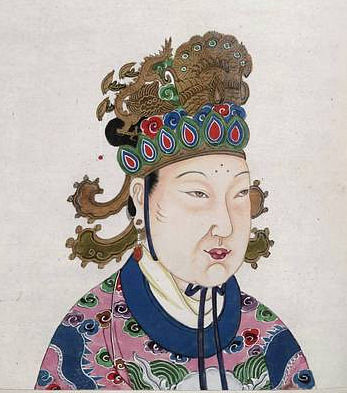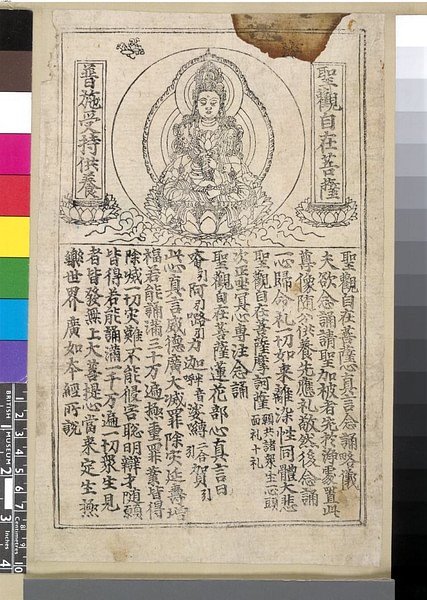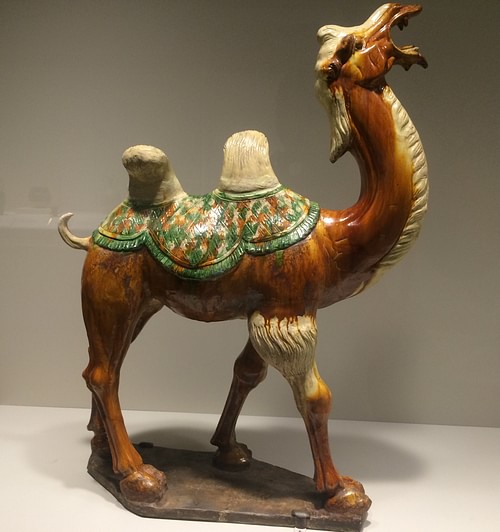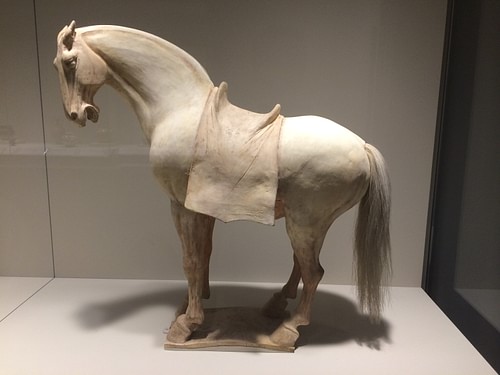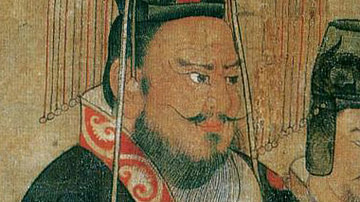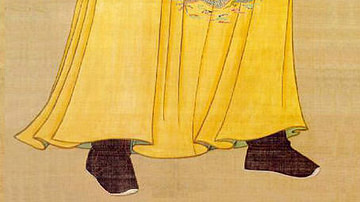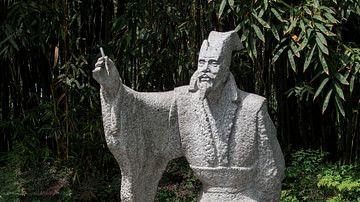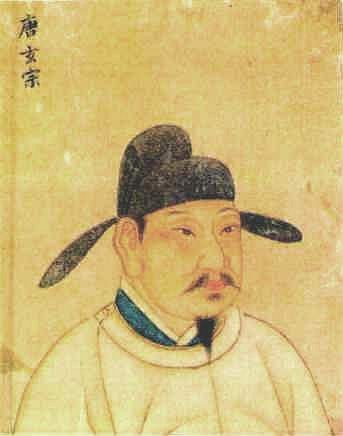
The Tang Dynasty (618-907 CE) was one of the greatest in Imperial Chinese history. It was a golden age of reform and cultural advancement which lay the foundation for policies which are still observed in China today. The second emperor, Taizong (r. 626-649 CE) was an exemplary ruler who reformed the government, social structure, military, education, and religious practices.
Under Taizong's successor, Gaozong (r. 649-683 CE), the country experienced further reforms when Gaozong's wife Wu Zetian (r. 624-705 CE) took control of the government. Wu Zetian is China's only female ruler, and even though she is still seen as a very controversial figure today, her reforms laid the foundation for the later success of the great emperor Xuanzong (r. 712-756 CE). Under the reign of Xuanzong, China became the most prosperous country in the world.
Many of the most impressive inventions and advancements in Chinese history (gunpowder, air conditioning, gas stoves, printing, advancements in medicine, science, technology, architecture, and literature) come from the Tang Dynasty. The emperors Taizong, Wu Zetian, and Xuanzong made the Tang Dynasty the great era that it was, and although the dynasty remained in power, the golden age ended with Xuanzong's decline which threw the country into chaos. The Tang were succeeded by the Sung Dynasty (960-1234 CE) who brought order back to China.
The Rise of the Tang Dynasty
After the fall of the Han Dynasty (202 BCE-220 CE), the country went through a period of changing rule in which the Wei, Jin, and Wu Hu dynasties governed in succession. The Wu Hu was replaced by the Sui Dynasty (589-618 CE), which began well and made many advances but, like so many dynasties in China's history, ended badly with a tyrant on the throne who cared more about himself and his luxury than the good of the people.
The Sui Dynasty was responsible for streamlining bureaucracy and a growing interest in the arts. One of the best-known versions of the legend of Mulan, the girl who takes her father's place in the army and becomes a war hero, dates from this period. However, the more comfortable and powerful the Sui became in their reign, the more power and luxury they wanted.
The last two kings, Wen and Yang, put all their efforts into military expansion in the Korean peninsula and building huge monuments to honor their names. Yang inherited a bankrupt government from his father but continued his policies and drove the country further and further into debt. He was finally assassinated by his chancellor, Yuwen Huaji, and a popular general of the army, Li-Yuan the Duke of Tang, rose in rebellion and took control. Li-Yuan then became Emperor Gaozu (r. 618-626 CE) and founded the Tang Dynasty.
Gaozu & Taizong
Gaozu was an effective monarch who reformed the policies which had led to abuses under the Sui Dynasty. It was Gaozu who implemented the bureaucratic practices which are still used in China today. Although he ruled well, his son, Li-Shimin, saw room for improvement. Li-Shimin had fought alongside his father to establish the Tang Dynasty and felt he should play a larger role in making policy. Li-Shimin was rewarded with the post of Duke of Qin (and became known as Qin Wang) but felt he deserved more.
Gaozu maintained his rule, though, creating the Tang Legal Code in 624 CE, which would be used by future dynasties and was even copied by other nations like Japan, Korea, and Vietnam. He also reformed the aristocracy to prevent over-taxation of the peasant farmers and re-distributed land parcels.
Around this time, he named his son Li-Jiancheng his heir, and this decree was more than Li-Shimin could tolerate; he had expected to be named because of his efforts in putting down the Sui rebellions. Li-Shimin staged a coup and murdered his brothers, including Li-Jiancheng, and then forced Gaozu to abdicate to him. Once he was emperor, he took the name Taizong, had his opponents executed, then used the concept of ancestor worship to his advantage and declared that all those who had been killed were now his celestial advisors.
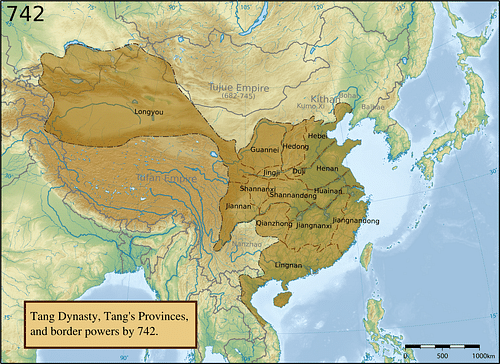
Taizong had shown himself to be such an effective general under his father's administration that no one challenged him once he took control. Their faith in him was not misplaced, and he proved himself to be an even more effective emperor than his father. Taizong is routinely cited for his many reforms and his policy of religious tolerance which allowed diverse religions such as Christianity and Buddhism to establish themselves in China alongside the indigenous practices of Confucianism and Taoism. Whatever his father had accomplished, Taizong improved upon and came to be regarded as co-founder of the Tang Dynasty and a model of just and efficient rule.
Wu Zetian
In around 638 CE Taizong chose a beautiful young 14-year-old girl named Wu Zhao as one of his concubines. She was so lovely, she attracted the attention of his son. Wu began an affair with Taizong's son Prince Li Zhi while still one of Taizong's concubines. When Taizong died in 649 CE, Wu submitted to the established custom and had her head shaved with the rest of Taizong's concubines. She was sent to a temple to live out the rest of her life as a nun, but Li Zhi, who now became Emperor Gaozong, had her brought back to court because he was in love with her.
Wu became Gaozong's first concubine, and his love for her upset his wife, Lady Wang, and the former first concubine, Lady Xiao. To get rid of them and increase her power, Wu is said to have murdered her own infant daughter and framed Lady Wang for the crime. She quickly became the power behind the throne, and when Gaozong died in 683 CE, she declared herself Empress Wu Zetian ('Ruler of Heaven' r. 683-704 CE) and changed the name of the dynasty to Zhou in order to show that a new era had begun.
Wu Zetian was one of the greatest rulers of ancient China, who improved education, taxation, agriculture and reformed the government and the excesses of the Chinese aristocracy. She has been criticized by later historians as a tyrant who created a secret police force and began a policy of paying informants to alert her to possible rebellions in the country. In recent years, though, there has been a trend among historians to re-evaluate these claims and Empress Wu's policies are now seen as stabilizing the country. Following the pattern of other rulers in China, she became more interested in her own comfort and pleasure toward the end of her reign and was forced to abdicate in favor of her son Zhongzong. She died in 705 CE.
Emperor Xuanzong
Emperor Zhongzong was poisoned by his wife, Lady Wei, so that her son could rule, but Wei and her son were murdered by Wu's daughter, Princess Taiping, who put her brother Ruizong, on the throne. Ruizong abdicated after seeing a comet, which he took as a sign he was not fit to rule (an interpretation suggested by Taiping) and his son Xuanzong (r. 712-756 CE) became emperor. Taiping had hoped she would be elevated by Xuanzong once he came to power and, when she saw that would not happen, she hanged herself.
Under Xuanzong's reign, the Tang Dynasty began its golden age. Under Taizong and Wu Zetian, Buddhism had been elevated as the most popular religion in the country, but Xuanzong saw Buddhist teachings as lacking in spirituality and so promoted Taoism and even decreed that "a copy of the Tao teaching be kept in every household" (Wintle, 148). Buddhism had given rise to many different schools of thought but Xuanzong felt Taoism was a unifying belief which would promote greater harmony. According to scholar Justin Wintle, his religious and political reforms resulted in domestic tranquility, which encouraged productivity and foreign trade.
Xuanzong abolished the death penalty, improved the economy through security on the Silk Road, maritime trading, and financial reforms, constructed temples and administrative complexes, built roads, and increased industry. He reorganized the military so that farmers were no longer conscripted against their will and built a professional army of veterans, who were more effective in guarding the borders and reclaiming land from nomadic tribes.
Cultural Advancements
Xuanzong was a cultured man, a poet, who patronized the arts and encouraged creative expression. Over 50,000 poems, plays, short stories, and other literary works were produced during the Tang Dynasty, mainly under Xuanzong's reign, and an encyclopedia was completed. Woodblock printing, which began on a large scale under Taizong, was improved, and more books became available which led to greater literacy and better jobs for the lower classes since they were now eligible to take civil service exams for government jobs.
Public libraries were built to collect all the books in print, and calendars were able to be printed for wide distribution. Advances in medicine, such as recognized symptoms of a disease and how to treat it, were available now outside the medical profession through books which also suggested preventative habits and promoted diet as contributing to a person's health.
Technological advances led to the creation of clocks, and the first clock mechanism in the world was invented by the engineer Yi Xing in 725 CE. Mechanical expertise also resulted in the creation of automatons, motorized figures, who moved by themselves. Even though motorized puppets had existed in China since the Qin Dynasty (221-206 BCE), the automatons of the Tang Dynasty were more complex and based on designs by Hero of Alexandria (l. c. 10-70 CE) who was famous for his inventions in Egypt. One example of Tang automatons was a motorized monk who collected donations, and another was an automatic wine-pourer shaped like a mountain which used a hydraulic pump.
The Tang Dynasty also invented gunpowder, waterproofing, fireproofing, gas stoves, and air conditioning. They developed agricultural machines to speed up the processes of planting, irrigating, and harvesting crops. The poor, who used to wear mainly animal skins, could now afford the linen worn by the middle class; though the material the poor could buy was coarser. The quality of life for the people of China improved radically, and the increase in trade brought new ideas, inventions, and products in greater numbers than ever before. The Tang Dynasty was at its height when Xuanzong began his personal decline which led to the fall of the entire dynasty and plunged the country into chaos.
The An Lushan Rebellion
Xuanzong's reign was so successful because he understood how a balanced rule promoted fairness and justice, which improved the lives of everyone. One of Wu Zetian's most important government reforms, which Xuanzong kept, was placing people in high positions based on merit instead of family connections. Teachers were hired because they knew their subject, not because they were another official's cousin, agricultural administrators were promoted to their position for the same reason, and so on with other appointments.
This policy began to change when Xuanzong became tired of public life c. 734 CE and began depending more on the advice of his consort Lady Wu Hui-fei who suggested he elevate a close friend of her family, Li-Linfu, to a more prominent position in order to take on some of the burden of rule. Li-Linfu was made chancellor and this one decision on the part of Xuanzong would do more to destroy the Tang Dynasty than any other. Li-Linfu was a corrupt and power hungry man who only cared about advancing himself. While he played the part of the devoted servant of the emperor he schemed to seize power himself and depose Xuanzong.
The emperor suspected nothing and placed great trust in Li-Linfu. In 737 CE Consort Wu died and Xuanzong withdrew further into his own pleasures and left the business of government to Li-Linfu. Xuanzong had over four thousand of the most beautiful women brought to the palace for his pleasure and kept them imprisoned there to entertain him. All of these women were nothing, however, once he saw the one who would be his true love and who would help hasten the decline of the Tang Dynasty as much as any plan Li-Linfu could have devised.
In 741 CE Xuanzong fell in love with a woman named Yang Guifei who was married to one of his sons. Yang left her husband and moved into the imperial palace with Xuanzong. He neglected his duties as emperor even further for this love affair and agreed to anything Lady Yang asked. She began with small requests, which he granted, and these grew into larger demands until she got him to promote members of her family to important positions even though these people could not do the jobs.
All of the important reforms and progress Xuanzong had made started to unravel as the members of Yang's family abused their positions and neglected their duties. All this time, Li-Linfu was making his own policies and promoting Yang family members whatever comfortable positions they could pay him for.
The policy of using foreign nationals in the army (which had grown out of Xuanzong's military reforms) led to the promotion of some of these men to very high positions of command and Li-Linfu took advantage of this to place his own hand-picked men in command. While some of these men were skilled commanders, many of them were not and owed their positions to Li-Linfu. When he died in 753 CE he had already doomed the dynasty he had pretended to serve. The unqualified commanders in the army and the incompetent bureaucrats in government only thought of their own power and luxury and the people suffered for it.
A half-Sogdian/half-Turk general named An Lushan saw the Yang family's abuses as a sign that Xuanzong was no longer fit to rule. An Lushan commanded the best troops in the Chinese army and felt he had a duty to take action and lead these men to restore a proper government; so he mounted a rebellion against the ruling house in 755 CE, leading his army of over 180,000 against the capital. He overthrew Xuanzong and declared himself emperor. He was challenged by the Tang forces and his rebellion crushed, but he had started something which could not be stopped. Between 755-763 CE, the country was torn apart by wars in which close to 36 million people died.
Xuanzong fled the capital in 755 CE with Lady Yang and her family. The men of the military escort, who accompanied them, blamed Yang for the troubles and murdered her family en route. Xuanzong realized he had allowed himself to be seduced away from his duties and allowed Lady Yang to be strangled. The story of the love affair of Xuanzong and Lady Yang was later romanticized by the Tang poet Bai-Juji in 806 CE in his famous work, Song of the Everlasting Sorrow (a poem which remains popular in the present day). After Lady Yang's death, Xuanzong abdicated in favor of his son Li Heng, who became Emperor Suzong (r. 756-762 CE). Suzong battled the rebel forces but could not defeat them completely.
He and his father became more and more depressed and frustrated as Suzong's strategies failed. Xuanzong died from illness in 762 CE, and Suzong died from the same sickness less than two weeks later. He was succeeded by his son Li Yu who became Emperor Daizong (reigned 762-779 CE). Daizong crushed the An Lushan rebellion in 763 CE, but the country was in ruins and the traditional respect given the emperor and royal house was compromised. Independent warlords now ruled different parts of China and Daizong could not command the kind of authority Xuanzong had at the beginning of his reign.
The Later Tang Dynasty
In 780 CE, Daizong was succeeded by his son, Dezong (r. 780-805 CE), who could do nothing to control the growing power of regional warlords. He placed palace eunuchs in command of his army, hoping they would have more success, but all they wound up doing was undermining the authority of the emperor by asserting their own military power. Dezong was succeeded by his sickly son Shunzong in 805 CE, who quickly abdicated in favor of his own son Xianzong (r. 806-820 CE).
Emperor Xianzong is among the very few good emperors of the later Tang Dynasty. He eliminated the eunuch control of his military and took personal control of the army. He then led his forces against the warlords and subdued them, stabilizing the country. He then reinstated the merit system of imperial appointments which Wu Zetian had initiated and had been such an important aspect of Xuanzong's successful reign. China began to slowly regain some measure of the prosperity it had known under Xuanzong's early rule as Xianzong restored respect for the authority of the throne.
In 813 CE, revolts began to break out, probably instigated by former warlords or their relatives, and Xianzong again led his army personally into battle but was defeated. He regrouped and won a victory over the insurgent Li Shidao in 817 CE, restoring order to the country. Shortly after this, the Confucian scholar Han Yu declared that these revolts and the decline of the dynasty were due to Buddhism, which undermined traditional Chinese values by diverting attention away from important traditions. Han Yu's criticism became widely known and created a backlash against Buddhists and Buddhist practices.
Xianzong did nothing about the persecutions of the Buddhists because, by 819 CE, he had become obsessed with his own mortality and was taking large quantities of elixirs which promised extended life and even immortality. These potions made him irritable and erratic, and he was assassinated by one of his palace eunuchs in 820 CE. Xianzong was succeeded by his son Muzong (r. 821-824 CE) who spent his time playing polo and drinking until he was killed in an accident during a polo match.
He was succeeded by his son Jinzong (r. 824-826 CE), who did nothing but waste his days drinking with his concubines until he was assassinated by his eunuchs and replaced by his brother Wenzong (r. 826-840 CE). Wenzong took his responsibilities seriously but was indecisive and easily swayed by different counselor's advice. He is considered a good emperor for his efforts at stabilizing the country and continuing the policies of Xianzong.
When he died in 840 CE, he was succeeded by his s16-year-old brother Wuzong (840-846 CE) who took Han Yu's criticism of Buddhism seriously and began a government persecution of all religions other than Taoism. He cited Han Yu's claim that Buddhist monasteries and temples were only fronts for rebel leaders and had them closed. Between 842-845 CE Buddhist nuns and priests were murdered or forced from their homes at the monasteries. Buddhist images were destroyed and many melted down to create new statues honoring the emperor.
Along with Buddhism, every other non-Chinese religion suffered as well. Manichaeism, Zoroastrianism, Judaism, and Nestorian Christianity (which had been welcomed by the second emperor Taizong) all equally suffered persecutions through destruction of their property and legal proscriptions. Wuzong died in 846 CE after poisoning himself with an elixir of immortality and was succeeded by Li Chen, the 13th son of Xianzong, who took the name Xuanzong in an effort to associate himself with the golden age of the Tang Dynasty, reigning from 846-859 CE.
Xuanzong II ended the religious persecutions of the previous years but only allowed Buddhist temples and monasteries to reopen. Churches, synagogues, and temples of Manichaeism and Zoroastrianism remained closed and these faiths proscribed. Xuanzong II modeled his reign after the great Taizong so closely that, after his death, he was referred to as "Little Taizong".
He revived the policies of the early Tang Dynasty and initiated reforms in government and the military. Chinese cultural heritage became a central focus of his reign as he tried to bring back the glory of the early years of the Tang. In 859 CE, however, Xuanzong II killed himself accidentally after drinking an elixir and was succeeded by his son Yizong (r. 859-873 CE) who was nothing like his father and would hasten the decline of the dynasty.
Decline & Fall of Tang
As one can see, the Tang Dynasty continued to hold on to power after 763 CE but it never again met its own former standard of excellence except in individual emperors such as Xianzong and Xuanzong II. Even though Taizong, Wu Zetian, and the first Xuanzong had created policies which any ruler could maintain, their reigns were successful because of their individual personalities and how they implemented the policies and reforms they created. Justin Wintle writes, "In retrospect, the Tang placed too great a faith in their own talents as imperial rulers" (139). In the case of all three of these emperors, their individual talents could not be transferred to a successor.
After the first Xuanzong's death, the dynasty steadily declined and fell apart. Xuanzong, like many rulers before and after him, lost sight of his responsibilities to the people and indulged his own pleasures at their expense. The An Lushan Rebellion exemplified how completely he had lost touch with his subjects and that revolt was only possible because the government had lost the respect and control of its subjects. Historian Harold M. Tanner comments on this:
The Tang dynasty is famous for its territorial expansion, its great cities and palaces, its flourishing foreign trade, its art, literature, and religious life, and for the luxurious lives of its aristocrats. This power and glory was possible only because the imperial government controlled grain production, labor, and armies. When the Tang state lost control of these things its power declined and it was less able to deal with internal and external crises. (172)
The final blow came with the Huang-Chao Rebellion (874-884 CE), led by a former government worker named Huang-Chao. Huang-Chao was a salt smuggler who repeatedly took the government's examinations to become a bureaucrat and failed. Frustrated by his inability to advance, as well as with the state of the country under the emperor Yizong, he joined the rebel forces of Wang Xianzhi. Yizong was a very poor ruler who placed his own pleasures over his duties to the people and spent more time drinking with his concubines than attending to affairs of state.
There was wide-spread famine in China due to drought and the government was doing nothing to help feed its people; though Yizong and the imperial court continued to enjoy the best food and drink. When Yizong died in 873 CE, his son Xizong (r. 873-888 CE) took the throne and continued his policies of gratifying himself at the people's expense. Huang-Chao had, by this time, risen in the ranks of the rebel forces and led his troops into battle against the Tang forces. This rebellion cost over 100,000 lives and destroyed the capital city of Changan.
The emperors of the Tang Dynasty who followed the Huang-Zhao rebellion were ineffective, and the dynasty ended in 907 CE. Zhaozong (r. 888-904 CE) was well-meaning and did his best but could not reverse the dynasty's decline, which had been steadily progressing since the An Lushan Rebellion. In 904 CE the powerful warlord Zhu Quanzhong (also known as Zhu Wen, l. 907-912 CE) had Zhaozong assassinated and placed the eleven-year-old son of Zhaozong, Ai, on the imperial throne as a puppet ruler.
Ai was the last of the Tang emperors and held the throne from 904-907 CE when Zhu had him assassinated at the age of 15. The Period of the Five Dynasties and Ten Kingdoms followed (907-960 CE) where the families and associates of the warlords who had claimed territories after the An Lushan Rebellion strengthened their control. China remained divided among these kingdoms until the rise of the Sung Dynasty (960-1234 CE) which united the country under central rule again.
